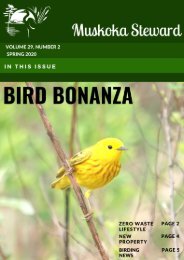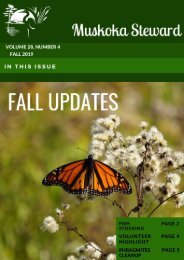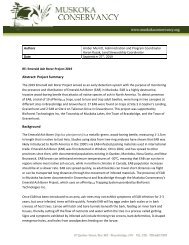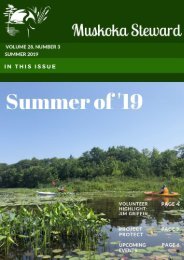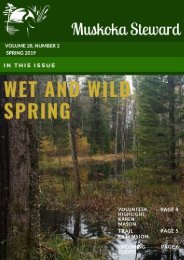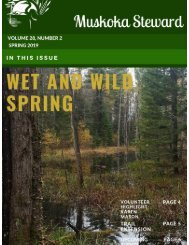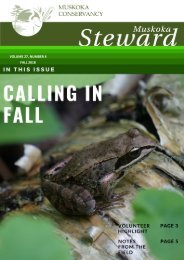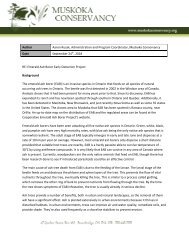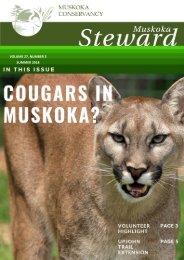EAB Report 2017
You also want an ePaper? Increase the reach of your titles
YUMPU automatically turns print PDFs into web optimized ePapers that Google loves.
Author<br />
Date October <strong>2017</strong><br />
Aaron Rusak, Administration and Program Coordinator, Muskoka Conservancy<br />
Background<br />
The emerald ash borer (<strong>EAB</strong>) is an invasive insect species that is native to parts of Asia. The beetle was<br />
first detected in Canada in 2002, in Windsor, Ontario. However, data from tree ring analysis showed that<br />
the beetle could have been present since the 1990s. Currently, the emerald ash borer has been detected<br />
in southwestern Canada, Ottawa, some parts of eastern Ontario and in both Sault Ste. Marie and<br />
Manitoulin Island. It has also been detected in parts of Quebec and in 21 states in the United States. The<br />
closest area to Muskoka that <strong>EAB</strong> has been detected in is the Ramara county near Orillia. The<br />
Cooperative Emerald Ash Borer Project has published a map that displays the known North American<br />
distribution.<br />
Emerald ash borers attack a number of different tree species, focusing mainly on native ash species. Five<br />
species of native ash, green, white, black, pumpkin, and blue ash, have all been attacked. However, the<br />
blue ash has proven to be slightly resistant to the species. <strong>EAB</strong> is a very hardy parasite, able to withstand<br />
temperature of -30°C through the production of antifreeze compounds. Additionally, from surveys in<br />
Michigan, very few native parasitoids are making transition to the <strong>EAB</strong>, though some have been<br />
discovered in China and Canada that may have an impact on <strong>EAB</strong> populations. Woodpeckers are the<br />
only native animals that feed on the <strong>EAB</strong>.<br />
The main cause of damage to ash trees is due to the feeding of the larvae. The larvae feed on the inner<br />
parts of the bark and impact the nutrient transportation system of the ash tree. The destruction of this<br />
nutrient transport system causes the tree to die through a process called girdling. Girdling is a process<br />
where a ring of bark is entirely removed from the tree, preventing nutrients to be carried to or from the<br />
roots.<br />
The removal of ash trees can have significant effects on the ecosystem of both forests and rivers. Loss of<br />
these trees causes erosion in the stream habitats they were part of. This adds more soil to the stream as<br />
well as changes the water temperature due to an increase in solar exposure. Loss of ash trees can also<br />
impact any populations of animals that depend on the ash tree for food or habitat.<br />
Project Description<br />
The <strong>EAB</strong> project was launched to understand the health of our forest ecosystems and detect whether<br />
any emerald ash borers had made their way into the Muskoka region. The project initially started with a<br />
single trap being put up in 2015. The following year, 20 traps were put up in the Bracebridge area and<br />
no <strong>EAB</strong> were found at the end of the study. This year’s project was undertaken in partnership with both<br />
the Town of Bracebridge and the Town of Gravenhurst, which allowed the scope to be increased from<br />
previous years. 24 traps were set in total, throughout the Gravenhurst and Bracebridge areas. BioForest<br />
Technologies generously donated the 24 traps used in the project.
The 24 ash tree sites were selected based upon a number of factors. Priority was give to trees growing in<br />
open areas, or with canopies that were accessible for trap placement. Additionally, areas where high<br />
traffic was to be expected were selected, so that any <strong>EAB</strong> moving on infected products would have the<br />
highest chance of being spotted.<br />
The green prism traps were baited with a pheromone and a green leaf volatile lure to draw the adult<br />
<strong>EAB</strong> beetles to the trap. They were placed in the low to mid canopy of the tree to increase the chances<br />
that any <strong>EAB</strong>s would contact the trap. The outside of the trap is quite sticky, trapping any beetles that fly<br />
toward the scent. Once the beetles make contact with the trap, they get stuck to the outside and cannot<br />
escape.<br />
Results<br />
The traps were checked and removed on September 20 th and 21 st . When the trap was removed, a<br />
member from Bioforest Technologies looked over the trap to check for the presence of Emerald Ash<br />
Borer. Due to inclement weather conditions in the summer, two of the traps were not recovered and<br />
thus, data was unable to be collected in those two locations.<br />
Of the traps surveyed, 12 specimens that were possibly <strong>EAB</strong> were discovered. A sample was sent to the<br />
Agricultural and Food Lab at the University of Guelph to verify whether or not they were <strong>EAB</strong>.<br />
Additionally, 5 samples were sent to the Great Lakes Forestry Centre in Sault Ste Marie for testing. The<br />
Great Lakes Forestry Centre confirmed that the five species sent to them were definitively not <strong>EAB</strong>. The<br />
sample that was sent to the University of Guelph couldn’t be definitely proven to be <strong>EAB</strong>.<br />
Project Successes<br />
This project was designed as early detection program for the presence of <strong>EAB</strong>. It was successful at<br />
determining the spread of <strong>EAB</strong> within the Bracebridge and Gravenhurst area. Additionally, it served as a<br />
way to raise public awareness of <strong>EAB</strong>, as well as increasing <strong>EAB</strong> presence in the media. A demonstration<br />
was held in June of this year, which covered the potential effects of <strong>EAB</strong> and what steps could be taken<br />
to deal with the problem. While putting up and removing the traps, many members of the public were<br />
interested in the project and wanted to learn more about the dangers of <strong>EAB</strong>. Additionally, many of the<br />
participants with traps on their property remarked about the interest of the neighbours and other<br />
people in the area. This public outreach is incredibly beneficial for further projects dealing with <strong>EAB</strong>, as it<br />
engages the public and creates more awareness of the potential problems of <strong>EAB</strong>.<br />
The partnership between both the Muskoka Conservancy and the Towns of Bracebridge and<br />
Gravenhurst is incredibly valuable and we hope to have continued opportunities to work together. As<br />
our project’s scope was larger this year, we were able to test a larger area, as well as an area closer to<br />
the current confirmed sightings of <strong>EAB</strong>. This allows us more time to prepare if <strong>EAB</strong> is found to be present<br />
and prepare a proper treatment plan if deemed necessary
Recommendations<br />
If this project were continued in future years, expansion of the area in which traps are placed would be<br />
an incredibly valuable way to increase the spread and success of this project. As <strong>EAB</strong> has been spotted in<br />
areas as close as Orillia, an early detection project allows us to increase our understanding of <strong>EAB</strong><br />
activity in the area. Getting other municipalities and towns on board with the project is another<br />
important way to protect Muskoka, as it increases the scope of the project. Another valuable<br />
municipality to have on board would be the Township of Muskoka Lakes. It is vital to expand the scope<br />
of the project, as the Muskoka region must be prepared for the possibility of <strong>EAB</strong> spreading to the area.<br />
Early detection of <strong>EAB</strong> allows the affected areas the maximum amount of time to establish a plan for the<br />
protection of the area.<br />
Another recommendation for the project would be to have a section of the study be focused on<br />
cataloguing the current state of the tree and checking for visible changes throughout the summer. This<br />
would allow us to identify trees that could be susceptible or already affected by emerald ash borer.<br />
Signs to look for would be epicormic shoots, bark cracking, yellowing of leaves, woodpecker damage, or<br />
canopy decline.<br />
Acknowledgements<br />
We would like to thank both the Town of Bracebridge and the Town of Gravenhurst for their support for<br />
this project. Their partnership is what allows us to continue this project and continue to monitor the<br />
movements of <strong>EAB</strong> in the Muskoka area.<br />
We would also like to thank Bioforest Technologies and their staff for the donation of time and<br />
resources to make this project a success. Their skills and knowledge in this area were very important in<br />
making this project successful.<br />
Finally, we’d like to thank all the Muskoka Conservancy volunteers and members who helped with the<br />
project or allowed us to place a trap on their property.
Figure 1: Map of <strong>2017</strong> <strong>EAB</strong> trap sites




